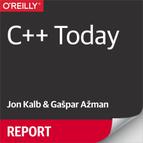Book Description
Now that software development is shifting primarily toward mobile and cloud computing, the venerable C++ programming language is returning to the dominant position it held during the object-oriented boom of the 1990s. In this O’Reilly report, you’ll learn why C++ is once again the preferred choice across several diverse industries, after taking a backseat to Java during the 2000s.
C++ is a complicated beast that's not easy to learn. But when you need a powerful, highly portable systems programming language or an application programming language with uncompromising performance, it’s hard to beat. With the 2011 and 2014 updates, C++ feels like a completely new language, rather than the old C++ with new features bolted on.
Authors Jon Kalb and Gašper Ažman demonstrate how modern C++ (C++11 and C++14) provides the power, performance, libraries, and tools necessary for massive server farms as well as low-footprint mobile apps.
- Delve into the modern C++ features that are generating new interest in the language
- Learn why C++ is the only high-level language available on Apple, Android, and Microsoft mobile devices
- Explore the C++ cloud computing appeal, including performance, high portability, and low-level hardware control
- See what the future holds for C++ with proposed changes in the 2017 update
